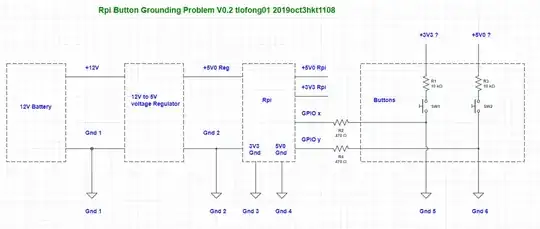Question
The Setup
Power to RpiZero = 12V Battery > 12V to 5V volgage regulator
Push button with one end connected to Rpi GPIO.

The Question
Is it OK to connect the other end of the button to the 12V battery ground?
Answer
Short answer
Yes, no problem.
Long Answer
Let us first look at Oreilly tutorial's push button circuit.

Then compare Oreilly circuit (green part) with the above circuit (pink part). The OP's question now boils down to
Should Button Ground 5 connected Rpi Ground 3 or Voltage Regulator
Ground 1?

/ to continue, ...
References
(1) Rpi Push button tutorial - Oreilly
(2) Electrial Circuit and Audio Equipment Ground Loop Problems And Howq to Get Rid of Them - Tomi Engdahl 2013
(3) Why 220V AC Mains Grounding Is Used? Tomi Engdahl 2013
/ to continue, ...
Appendices
Appendix A - Ground Loop Reading Notes
Electrial Circuit and Audio Equipment Ground Loop Problems And Howq to Get Rid of Them - Tomi Engdahl 2013
What is "Ground Loop"?
Ground loop is a condition where an unintended connection to ground is
made through an interfering electrical conductor.
Generally ground loop connection exists when an electrical system is
connected through more than one way to the electrical ground. When two
or more devices are connected to a common ground through different
paths, a ground loop occurs.
Currents flow through these multiple paths and develop voltages which
can cause damage, noise or 50Hz/60Hz hum in audio or video equipment.
To prevent ground loops, all signal grounds need to go to one common
point and when two grounding points cannot be avoided, one side must
isolate the signal and grounds from the other.
What is "Ground"?
The NEC, National Electrical Code defines a ground as: "a conducting
connection, whether intentional or accidental between an electrical
circuit or equipment and the earth, or to some conducting body that
serves in place of the earth."
What is the difference between Equipment Grounding and Earth Grounding?
When talking about grounding it is actually two different subjects,
earth grounding and equipment grounding.
Earth grounding is an intentional connection from a circuit conductor
usually the neutral to a ground electrode placed in the earth.
Equipment grounding is to ensure that operating equipment within a
structure is properly grounded.
These two grounding systems are required to be kept separate except
for a connection between the two systems to prevent differences in
potential from a possible flashover from a lightning strike.
The purpose of a ground besides the protection of people plants and
equipment is to provide a safe path for the dissipation of Fault
Currents, Lightning Strikes, Static Discharges, EMI and RFI signals
and Interference.
Improper grounding can create a lethal hazard. Correct grounding is
essential for correct operation and safety of electrical equipments.
Grounding can solve many problems, but it can also cause new ones. One
of the most common problem is called "ground loop".
What is the difference between "Ground" and "Common"?
Audio and video systems need a reference point for their voltages.
Generally referred to as common or ground, although it may not be
actually connected with the earth, this reference remains at "zero
volts" while other signal voltages "swing" positive (above) and
negative (below) it.
Physically, the common may be a wire, a trace on a printed-circuit
board, a metal chassis, virtually anything that conducts electricity.
Ideally it should be a perfect conductor, but in any practical system
it is not. As the complexity and size of the system is increased, the
imperfect conductivity of the common (ground) conductor inevitably
causes problems.
Why ground loop is a problem ?
Ground loops are a mystery to many people. Even college-trained
electronic engineers may not know what ground loops actually are.
Engineers have either concentrated on power distribution (for the
electric company) or on equipment that happens to plug in to the power
distribution system.
Not much thought has been given to power distribution and equipment as
a single entity where ground loops arise. Ground loops are the most
common cause of AC line frequency hum in sound systems.
Ground loops can be generally identified by a low hum (60Hz in the US,
50Hz in Europe) through the sound system. A ground loop in the power
or video signal occurs when some components in the same system are
receiving its power from a different ground than other components, or
the ground potential between two pieces of equipment is not identical.
Ground loop is a common problem when connecting multiple audio-visual
system components together, there is a good change of making a nasty
ground loops.
Ground loops commonly cause humming noise to audio signals and
interference bars to picture. Ground loop makes the system sensitive
to pick up interference from mains wiring which can lead to erratic
operation of the equipments or even damages to the equipments. Some
articles claim that wiring and grounding problems account for up to 80
percent of all power quality related problems related with sensitive
electronic equipments like audio/video systems.
End of answer


